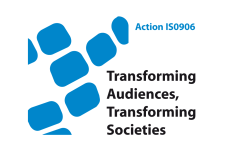- About the Action
- Events
- PhD workshop - Ljubljana 2014
- Action Open Conference - Ljubljana 2014
- New Media and Participation conference - Istanbul 2013
- Belgrade meeting 2013
- Media literacy research and policy - Brussels 2013
- ICA Pre-Conference 2013
- Tampere meeting 2013
- Budapest workshop 2012
- Milan meeting 2012
- Brussels PhD workshop 2012
- Brussels Action workshop 2012
- London meeting 2011
- Zagreb Conference 2011
- Lisbon meeting 2010
- Affiliated events
- WG 1
- WG 2
- WG 3
- WG 4
- Cross-WG
- Output
Dealing with the categorial crisis of “the audience”: A critical analysis of the sense-making strategies on “the audience”
Patriarche, G. (2012). Dealing with the categorial crisis of “the audience”: A critical analysis of the sense-making strategies on “the audience”. 4th European Communication Conference ECREA, Istanbul: 24-27 October.
Abstract: For several decades, the conceptual category of “audience” has been challenged because of the diversification of audience theory into several research traditions, the social and technical transformations of media and communication practices (e.g. the digitalization, individualization and convergence of media and communication), and the endorsement of constructivist epistemologies by audience research (e.g. Ang, 1991). While some quite radical claims have been made concerning, for instance, the “death” of the audience (Holmes & Jermyn, 2006) and the need to move away from “media studies” and to embrace “software studies” (Manovich, 2001), the categorial crisis of “the audience” has actually led researchers to develop a variety of conceptual strategies in order to make sense of (or in some cases reject) the category of audience. The aim of this paper is to review these strategies and to evaluate their heuristic value for the study of contemporary media practices. The literature review and analysis identify six strategies that can be grouped in three broad classes. For each strategy, several examples are provided, and their rationale and conceptual/theoretical implications are thoroughly discussed, referring to current debates and developments in so-called audience research. The solutions of change include the substitution of the category of audience by another category (e.g. talking of “users” instead of “audiences”), and the hybridization between “the audience” and another category (think for instance of the category of “produser” coined by Bruns). The solutions of continuity include the articulation of the “audience” with other categories, each of which identifying a media practice on its own (e.g. Jensen, 2010; Ridell, in press), and the dissociation of the definitional criteria of “the audience” (e.g. Livingstone, 2005). Finally, one can find a couple of intermediate solutions such as the floating of “the audience” between diverse theories (e.g. Carpentier, 2004) and the diversification of “the audience” into multiple practices (e.g. Abercrombie & Longhurst, 1998). The final part of the paper intends to elaborate on the solutions of continuity discussed above, outlining a broad theoretical framework which would allow to make sense of the category of audience in both a changing research field and a changing media and communication environment. The framework is organized along six theoretical lines: (1) The audience is a media practice on its own, which should be distinguished from other kinds of practices such as the public and the user; (2) The audience has something to do with participation, understood in both sociological and political terms (see respectively Goffman, 1981, and Carpentier, 2011); (3) Participatory practices are various in terms of forms and contents; (4) Participation should not be mistaken for engagement, although both notions are related (Dahlgren, 2006); (5) Participatory practices can be linked together as well as embedded in one another; and (6) Participatory practices are configured through political-economical, technological, discursive, social-cultural, and ideological logics.

